Posted by Beth on Friday, Oct 20, 2017
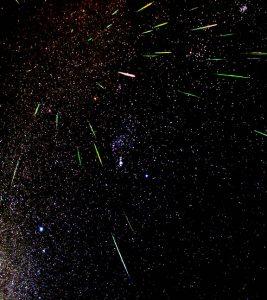 If you're not often outside late at night, you might not be aware that something pretty special has been going on this week. The 2017 Orionid Meteor Shower began on October 15 and ends October 29th. Peak nights for viewing the meteor shower are tonight and tomorrow night - with prime viewing time around around 2:00a.m Saturday and Sunday.
If you're not often outside late at night, you might not be aware that something pretty special has been going on this week. The 2017 Orionid Meteor Shower began on October 15 and ends October 29th. Peak nights for viewing the meteor shower are tonight and tomorrow night - with prime viewing time around around 2:00a.m Saturday and Sunday.
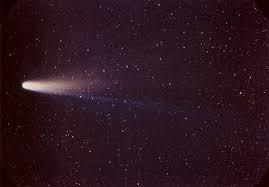 The Orionids happen every year in late October when the earth passes through the stream of ice particles and rocks trailing Haley's Comet. Haley's Comet has a highly elliptical 75.5 year orbit around the Sun. It last passed through the inner part of the solar system in 1986. Each time it passes the Sun a bit of the ice on the comet melts and rocks and larger chunks of ice break off and join the stream of debris following the comet.
The Orionids happen every year in late October when the earth passes through the stream of ice particles and rocks trailing Haley's Comet. Haley's Comet has a highly elliptical 75.5 year orbit around the Sun. It last passed through the inner part of the solar system in 1986. Each time it passes the Sun a bit of the ice on the comet melts and rocks and larger chunks of ice break off and join the stream of debris following the comet.
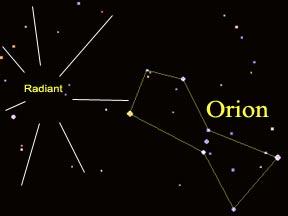
The Orionid Meteor Shower gets its name from the fact that the point in the sky that the meteors appear to originate from - called the Radiant - is just next to the constellation Orion.
Orion - named for the hunter i
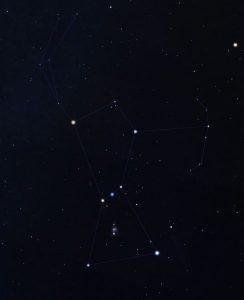 n Greek mythology - is easily recognizable in the night sky if you look for three bright stars close together in a strait line - this is "Orion's Belt." (See the yellow highlight below.)
n Greek mythology - is easily recognizable in the night sky if you look for three bright stars close together in a strait line - this is "Orion's Belt." (See the yellow highlight below.)
Orion is one of the most prominent constellations in the sky. Due to it's location on the celestial equator, it can be seen from all over the world. (The celestial equator is an imaginary line projected in space directly above the Earth's equator.)
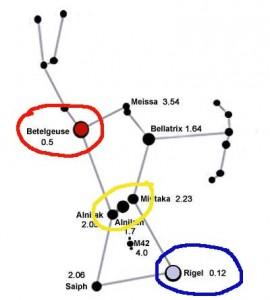
The two brightest stars in Orion are the blue-white supergiant Rigel and the red supergiant Betelgeuse.
We're lucky this year - the moon is just past new which means it will be only a small crescent early in the evenings. Late at night it will be nice and dark. Last year we had a Fall Supermoon, which created so much light it was hard to see the smaller meteors.
You have two more chances to view meteor showers in 2017. The Leonids will peak on November 16 during a new moon and the Geminids on December 13th with a morning crescent moon. Cross your fingers and hope for clear skies in Iowa.
To learn more about Star Gazing, visit the books at 523.8 on the second floor.


If you've ever wanted to learn how to machine quilt with your home sewing machine, I highly recommend Angela Walters and either her YouTube show The Midnight Quilt Show or this book Free-Motion Meandering. She makes it seem so simple. Meandering is a simple designed that is repeated to fill in an area on a quilt, and once you learn one or two designs you're on your way! -Beth